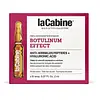What's inside
What's inside
 Key Ingredients
Key Ingredients

 Benefits
Benefits

 Concerns
Concerns

No concerns
 Ingredients Side-by-side
Ingredients Side-by-side

Water
Skin ConditioningPentylene Glycol
Skin ConditioningSchisandra Chinensis Fruit Extract 10.1%
Skin ConditioningGlycerin
HumectantSaccharomyces/Xylinum/Black Tea Ferment
Skin ConditioningPropanediol
SolventAloe Barbadensis Leaf Juice
Skin ConditioningDiglycerin
HumectantTrehalose
HumectantXanthan Gum
EmulsifyingSodium Phytate
Eclipta Prostrata Extract
Skin ConditioningCitrus Iyo Fruit Extract
EmollientCalendula Officinalis Extract
Skin ConditioningSodium Hyaluronate
HumectantHouttuynia Cordata Extract
Skin ConditioningCaprylyl Glycol
EmollientYeast Beta-Glucan
Skin ConditioningWater, Pentylene Glycol, Schisandra Chinensis Fruit Extract 10.1%, Glycerin, Saccharomyces/Xylinum/Black Tea Ferment, Propanediol, Aloe Barbadensis Leaf Juice, Diglycerin, Trehalose, Xanthan Gum, Sodium Phytate, Eclipta Prostrata Extract, Citrus Iyo Fruit Extract, Calendula Officinalis Extract, Sodium Hyaluronate, Houttuynia Cordata Extract, Caprylyl Glycol, Yeast Beta-Glucan
Water
Skin ConditioningPropanediol
SolventGlycerin
Humectant1,2-Hexanediol
Skin ConditioningSodium Hyaluronate
HumectantTrehalose
HumectantBeta-Glucan
Skin ConditioningHordeum Vulgare Seed Extract
Skin ConditioningDipeptide Diaminobutyroyl Benzylamide Diacetate
Skin ConditioningCaprylyl Glycol
EmollientPentylene Glycol
Skin ConditioningSodium Gluconate
Skin ConditioningMaltodextrin
AbsorbentLecithin
EmollientXanthan Gum
EmulsifyingSodium Acrylates Copolymer
Menthyl Lactate
MaskingHydroxyacetophenone
AntioxidantAcacia Senegal Gum
MaskingSodium Benzoate
MaskingParfum
MaskingWater, Propanediol, Glycerin, 1,2-Hexanediol, Sodium Hyaluronate, Trehalose, Beta-Glucan, Hordeum Vulgare Seed Extract, Dipeptide Diaminobutyroyl Benzylamide Diacetate, Caprylyl Glycol, Pentylene Glycol, Sodium Gluconate, Maltodextrin, Lecithin, Xanthan Gum, Sodium Acrylates Copolymer, Menthyl Lactate, Hydroxyacetophenone, Acacia Senegal Gum, Sodium Benzoate, Parfum
 Reviews
Reviews

Ingredients Explained
These ingredients are found in both products.
Ingredients higher up in an ingredient list are typically present in a larger amount.
Caprylyl Glycol is a humectant and emollient, meaning it attracts and preserves moisture.
It is a common ingredient in many products, especially those designed to hydrate skin. The primary benefits are retaining moisture, skin softening, and promoting a healthy skin barrier.
Though Caprylyl Glycol is an alcohol derived from fatty acids, it is not the kind that can dry out skin.
This ingredient is also used as a preservative to extend the life of products. It has slight antimicrobial properties.
Learn more about Caprylyl GlycolGlycerin is already naturally found in your skin. It helps moisturize and protect your skin.
A study from 2016 found glycerin to be more effective as a humectant than AHAs and hyaluronic acid.
As a humectant, it helps the skin stay hydrated by pulling moisture to your skin. The low molecular weight of glycerin allows it to pull moisture into the deeper layers of your skin.
Hydrated skin improves your skin barrier; Your skin barrier helps protect against irritants and bacteria.
Glycerin has also been found to have antimicrobial and antiviral properties. Due to these properties, glycerin is often used in wound and burn treatments.
In cosmetics, glycerin is usually derived from plants such as soybean or palm. However, it can also be sourced from animals, such as tallow or animal fat.
This ingredient is organic, colorless, odorless, and non-toxic.
Glycerin is the name for this ingredient in American English. British English uses Glycerol/Glycerine.
Learn more about GlycerinPentylene glycol is typically used within a product to thicken it. It also adds a smooth, soft, and moisturizing feel to the product. It is naturally found in plants such as sugar beets.
The hydrophilic trait of Pentylene Glycol makes it a humectant. As a humectant, Pentylene Glycol helps draw moisture from the air to your skin. This can help keep your skin hydrated.
This property also makes Pentylene Glycol a great texture enhancer. It can also help thicken or stabilize a product.
Pentylene Glycol also acts as a mild preservative and helps to keep a product microbe-free.
Some people may experience mild eye and skin irritation from Pentylene Glycol. We always recommend speaking with a professional about using this ingredient in your routine.
Pentylene Glycol has a low molecular weight and is part of the 1,2-glycol family.
Learn more about Pentylene GlycolPropanediol is an all-star ingredient. It softens, hydrates, and smooths the skin.
It’s often used to:
Propanediol is not likely to cause sensitivity and considered safe to use. It is derived from corn or petroleum with a clear color and no scent.
Learn more about PropanediolSodium Hyaluronate is hyaluronic acid's salt form. It is commonly derived from the sodium salt of hyaluronic acid.
Like hyaluronic acid, it is great at holding water and acts as a humectant. This makes it a great skin hydrating ingredient.
Sodium Hyaluronate is naturally occurring in our bodies and is mostly found in eye fluid and joints.
These are some other common types of Hyaluronic Acid:
Learn more about Sodium HyaluronateTrehalose is a disaccharide made of two glucose molecules (glucose is sugar!). Trehalose is used to help moisturize skin. It also has antioxidant properties.
As a humectant, trehalose helps draw moisture from the air to your skin. This helps keep your skin hydrated.
Due to its antioxidant properties, trehalose may help with signs of aging. Antioxidants help fight free-radical molecules, unstable molecules that may damage your skin.
In medicine, trehalose and hyaluronic acid are used to help treat dry eyes.
Some animals, plants, and bacteria create trehalose as a source of energy to survive freeze or lack of water.
Learn more about TrehaloseWater. It's the most common cosmetic ingredient of all. You'll usually see it at the top of ingredient lists, meaning that it makes up the largest part of the product.
So why is it so popular? Water most often acts as a solvent - this means that it helps dissolve other ingredients into the formulation.
You'll also recognize water as that liquid we all need to stay alive. If you see this, drink a glass of water. Stay hydrated!
Learn more about WaterXanthan gum is used as a stabilizer and thickener within cosmetic products. It helps give products a sticky, thick feeling - preventing them from being too runny.
On the technical side of things, xanthan gum is a polysaccharide - a combination consisting of multiple sugar molecules bonded together.
Xanthan gum is a pretty common and great ingredient. It is a natural, non-toxic, non-irritating ingredient that is also commonly used in food products.
Learn more about Xanthan Gum